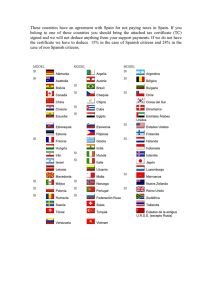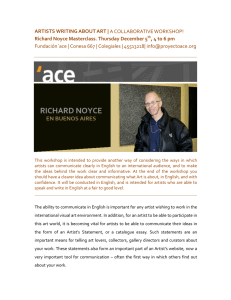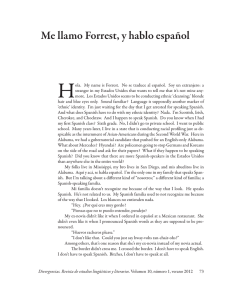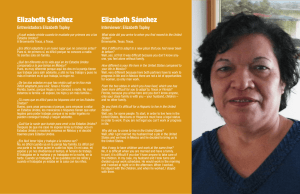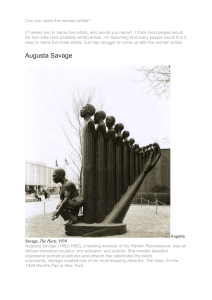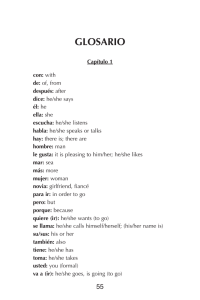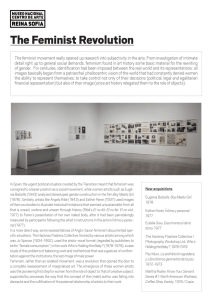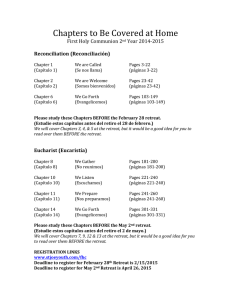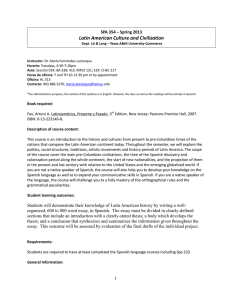Preview - tadamsspanishahs
Anuncio
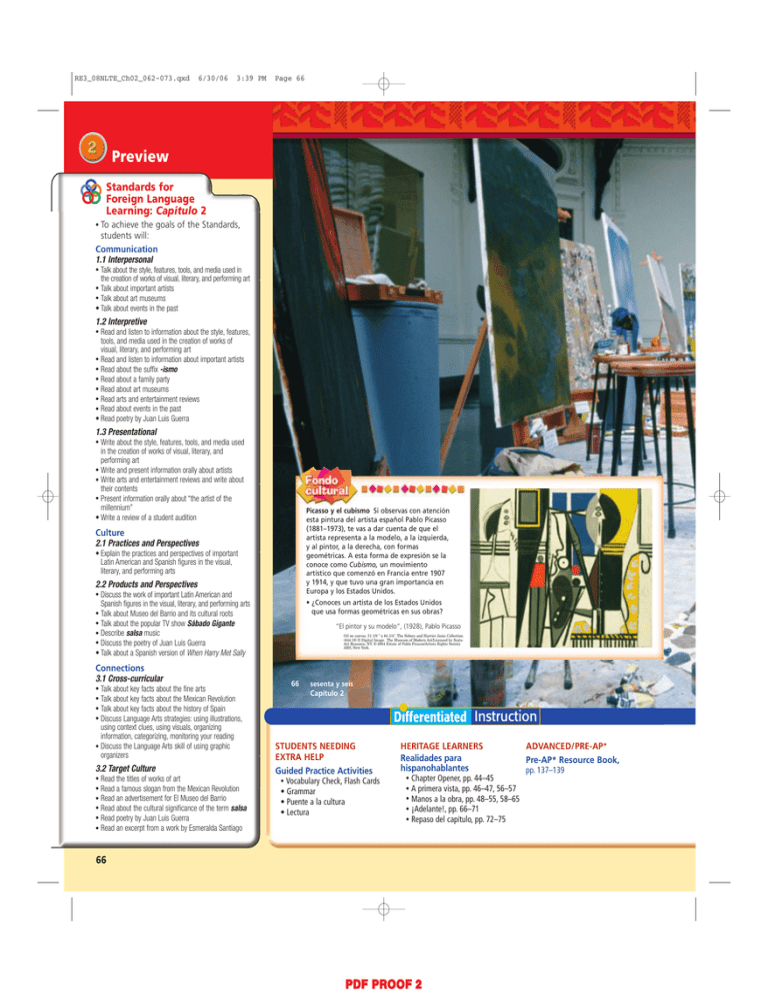
RE3_08NLTE_Ch02_062-073.qxd 6/30/06 3:39 PM Page 66 Preview Standards for Foreign Language Learning: Capítulo 2 To achieve the goals of the Standards, students will: Communication 1.1 Interpersonal • • Talk about the style, features, tools, and media used in the creation of works of visual, literary, and performing art • Talk about important artists • Talk about art museums • Talk about events in the past 1.2 Interpretive • Read and listen to information about the style, features, tools, and media used in the creation of works of visual, literary, and performing art • Read and listen to information about important artists • Read about the suffix -ismo • Read about a family party • Read about art museums • Read arts and entertainment reviews • Read about events in the past • Read poetry by Juan Luis Guerra 1.3 Presentational • Write about the style, features, tools, and media used in the creation of works of visual, literary, and performing art • Write and present information orally about artists • Write arts and entertainment reviews and write about their contents • Present information orally about “the artist of the millennium” • Write a review of a student audition Picasso y el cubismo Si observas con atención esta pintura del artista español Pablo Picasso (1881–1973), te vas a dar cuenta de que el artista representa a la modelo, a la izquierda, y al pintor, a la derecha, con formas geométricas. A esta forma de expresión se la conoce como Cubismo, un movimiento artístico que comenzó en Francia entre 1907 y 1914, y que tuvo una gran importancia en Europa y los Estados Unidos. Culture 2.1 Practices and Perspectives • Explain the practices and perspectives of important Latin American and Spanish figures in the visual, literary, and performing arts 2.2 Products and Perspectives • Discuss the work of important Latin American and • ¿Conoces un artista de los Estados Unidos que usa formas geométricas en sus obras? Spanish figures in the visual, literary, and performing arts Talk about Museo del Barrio and its cultural roots Talk about the popular TV show Sábado Gigante Describe salsa music Discuss the poetry of Juan Luis Guerra • Talk about a Spanish version of When Harry Met Sally • • • • “El pintor y su modelo”, (1928), Pablo Picasso Oil on canvas. 51 1/8 " x 64 1/4". The Sidney and Harriet Janis Collection. (644.19) © Digital Image. The Museum of Modern Art/Licensed by ScalaArt Resource, NY. © 2004 Estate of Pablo Picasso/Artists Rights Society ARS, New York. Connections 3.1 Cross-curricular Talk about key facts about the fine arts Talk about key facts about the Mexican Revolution Talk about key facts about the history of Spain Discuss Language Arts strategies: using illustrations, using context clues, using visuals, organizing information, categorizing, monitoring your reading • Discuss the Language Arts skill of using graphic organizers 66 • • • • 3.2 Target Culture • • • • • • Read the titles of works of art Read a famous slogan from the Mexican Revolution Read an advertisement for El Museo del Barrio Read about the cultural significance of the term salsa Read poetry by Juan Luis Guerra Read an excerpt from a work by Esmeralda Santiago 66 sesenta y seis Capítulo 2 STUDENTS NEEDING EXTRA HELP Guided Practice Activities Vocabulary Check, Flash Cards • Grammar • Puente a la cultura • Lectura • HERITAGE LEARNERS Realidades para hispanohablantes • • • • • Chapter Opener, pp. 44–45 A primera vista, pp. 46–47, 56–57 Manos a la obra, pp. 48–55, 58–65 ¡Adelante!, pp. 66–71 Repaso del capítulo, pp. 72–75 ADVANCED/PRE-AP* Pre-AP* Resource Book, pp. 137–139 RE3_08NLTE_Ch02_062-073.qxd 6/21/06 9:54 AM Page 67 Preview Standards for Foreign Language Learning (cont’d) ¿Cómo te expresas? Comparisons 4.1 Language • Compare Spanish words to their English counterparts • Compare the use and meanings of Spanish compara- tives and superlatives to those in English • Compare the uses of English and Spanish past tenses Chapter Objectives 4.2 Culture • Compare growing up in one culture to growing up in • • • • • • Talk about the arts Give an opinion about a work of art Relate the arts to your own experience Describe how people express themselves Narrate events in the past Discuss some important artists of the Spanish-speaking world more than one culture Communities 5.1 Beyond the School • Link to Web sites from around the Spanish-speaking world 5.2 Lifelong Learner • • • • • Music, dance, and art in the Spanish-speaking world Chapter Opener As you learn about the arts, you will make connections to these countries and places. AT L A S Core Instruction Resources: Voc. and Gram. Transparencies: España Estados Unidos México Cuba Develop an appreciation for artistic role models Develop an appreciation for the fine arts Recognize sources of artistic inspiration Discuss the impact culture has on the formation of personality Maps 14, 16–20, 22 Suggestions: Introduce students to the theme of the chapter and go over the objectives. Point out that they will learn about artists from around the Spanishspeaking world who work in a variety of media and styles. Puerto Rico Ecuador Chile Argentina Standards: 1.1, 1.2, 2.2, 3.1 Más práctica ● Real. para hispanohablantes, p. 45 Resources: Fine Art Transparencies with For: Online Atlas Web Code: jee-0002 Teacher’s Guide, p. 48 sesenta y siete Capítulo 2 Teacher Technology 67 Suggestions: Remind students that the painting shows an artist in a studio, painting a model. Have volunteers point to various parts of the painting and say what they think they portray. Answers will vary, but may include American cubists such as Stuart Davis, Alfred Maurer, or Max Weber. PLAN TEACH Lesson Planner Teaching Resources Interactive Teacher’s Edition For: Teacher Home Page Vocabulary Clip Art Web Code: jek-1001 ASSESS TEACH Chapter Quizzes and Tests Vocabulary & Grammar Powerpoints Audio & Clip Art Activities Transparencies and Maps Activity Answers Photo Gallery ASSESS Teaching with Art Resources: Fine Art Transparencies with Teacher’s Guide, p. 48 67
